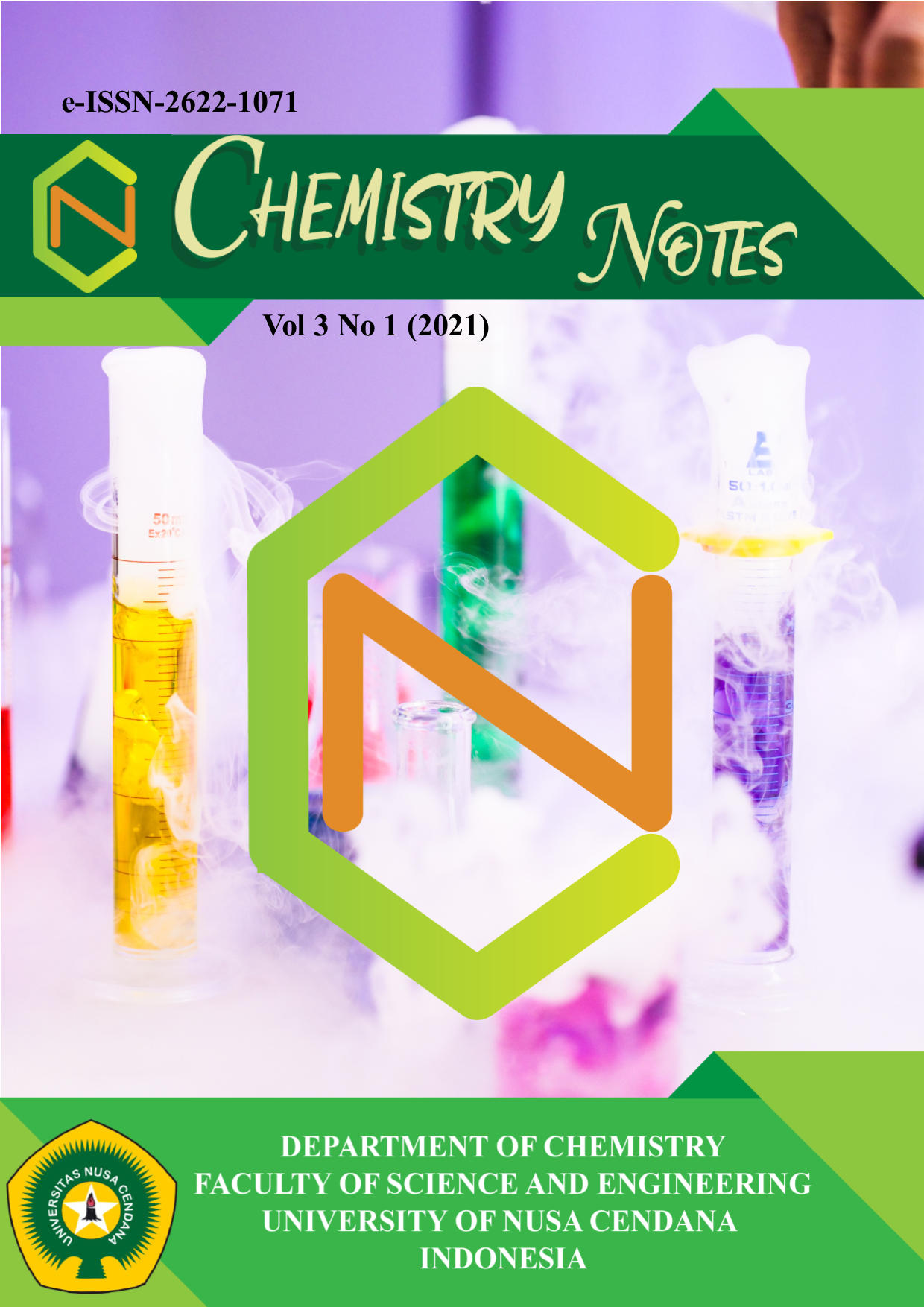Purification and Characterization of Silica Rice Husk Ash (Oryza Sative L.) From Kupang Regency
Abstract
This research had been done to purify and characterize silica from rice husk ash for two varieties of rice from Kupang Regency. The purification method used is the extraction method with alkaline solution (NaOH) and precipitation with acid solution (H2SO4). The stages in this research were preparation of rice husk ash, purification of silica rice husk ash with NaOH and H2SO4 solutions, and characterization covered: determination of acidity and surface area and determination of composition using X-ray fluorescence spectrophotometer (XRF). The results of the surface acidity test showed that the highest acidity was in Ciherang silica from Tarus, which was 2.288 mmol/g. While the surface area test showed that the largest surface area was Inpari 46 silica from Pariti, which was 184.297 m2/g with an optimum contact time of 50 minutes. The results of characterization using XRF exhibited that the highest silica purity was Ciherang rice variety from Tarus, with initial silica content data, purification with NaOH and H2SO4 were 93.9%; 98.2% and 99.1%. So that the purification process with NaOH and H2SO4 is proven to increase the silica content in the sample.
Downloads
References
2. Enymia, Suhanda, dan Sulistarihani, N., 1998, Pembuatan Silika Gel dari Sekam Padi untuk Bahan Pengisi Karet Ban, Jurnal Keramik dan Gelas Indonesia, Vol. 7, No. 1 dan 2.
3. Kalapathy, U., Proctor, A., dan J. Shultz, 2000, A Simple Methode for Production of Pure Silika from Rice Hull Ash, Bioresource Technology, 73: 257-262.
4. Nuryono, Narsito, dan Astuti, E., 2004, Sintesis Silika Gel Terenkapsi Enzim dari Abu Sekam Padi dan Aplikasinya Untuk Biosensor, (Laporan Penelitian Hibah Bersaing XI/2), Lembaga Penelitian UGM, Yogyakarta.
5. Folleto, E.L., Ederson, G., Leonardo, H.O., Sergio, J., 2006, Conversion of Rice Hull Ash Into Sodium Silicate, Material Research, Vol. 9, No. 3,335-338.
6. Agung, G.F., Hanafie, M.R., dan Mardina, P., 2013, Ekstraksi Silika Dari Abu Sekam Padi Dengan Pelarut KOH, Jurnal Konversi, Vol. 2, No.1, Program Studi Teknik Kimia, Fakultas Teknik, Universitas Lambung Mangkurat.
7. Sriyanto dan Darwanta, 2017, Kajian Pengaruh Jenis Asam pada Pemurnian Abu Sekam Padi, AVOGADRO Jurnal Kimia, Vol. 1, No. 1, Jurusan Kimia, FMIPA, Universitas Cenderwasih, Jayapura.
8. Yuvakkumar, R., Elango, V., Rajendran, V., dan Kannan, N., 2014, High-purity Nano Silica Powder from Rice Husk Using A Simple Chemical Method, Journal of Experimental Nanoscience, Vol. 9, No. 3.
9. Harimu, L., Rudi, L., Haetami, A., Santoso, G.A.P., dan Asriyanti, 2019, Studi Variasi Konsentrasi NaOH dan H2SO4 untuk Memurnikan Silika dari Abu Sekam Padi Sebagai Adsorben Ion Logam Pb2+ dan Cu2+, Indo. J. Chem. Res., Vol. 6, No. 2.
10. Darmawan, 2006, The Effects of Long-term Intensive Rice Cultivation on the Available Silica Content of Sawah Soils; The Case of Java Island, Indonesia, Soil Sci Plant Nut, Vol. 52: 745-753.
11. Kyuma, K., 2004, Paddy Soil Science, Kyoto University Press and Trans Pacific Press: Melbourne.
12. Go, B.H., 1984, Pemupukan Tanaman Padi Gogo, Prasarana Raker, Padi Tanah Kering, Kaliurang 6-8 Juli 1984.
13. Kurniawati, 2003, Sintesis Silika Gel dari Abu Sekam Padi Menggunakan NaOH dan Asam Sitrat, Skripsi, FMIPA, Universitas Gajah Mada, Yogyakarta.
14. Amin, M., Nugroho, B., Suryaningtyas, D.T., dan Suwarno, 2019, Respons Pemberian dan Penetapan Status Hara Si Pada Tanaman Padi, Jurnal Ilmu Pertanian Indonesia, Vol 24(1): 32-40.
15. Mujiyanti D.R., Nuryono, Eko Sri Kunarti, 2010, Sintesis dan Karakterisasi Silika Gel dari Abu Sekam Padi Yang Diimobilisasi Dengan 3-(Trimetoksisilil)-1-Propantiol, Sains dan Terapan Kimia, 4(2), 150-167.
16. Effendi, A.H., 2007, Natrium Silikat Sebagai Bahan Penghambat Api Aman Lingkungan, Jurnal Teknik Lingkungan, 8(3):245-252.
17. Wogo, H.E., Segu, J.O., dan Ola, P.D., 2011, Sintesis Silika Gel Terimobilisasi Dithizon melalui Proses Sol-Gel, Sains dan Terapan Kimia, Vol. 5, No. 1, 84-95, Jurusan Kimia, FST, Universitas Nusa Cendana, Kupang.
18. Wogo, H.E., Kadang, L., dan Mir, M.A., 2014, Termodinamika Adsorpsi Ca(II) dan Cd(II) pada Adsorben Ampas Tahu, Sains dan Terapan Kimia, Vol. 8, No. 2, 120-128, Jurusan Kimia, FST, Universitas Nusa Cendana, Kupang.
In order to publish in Chemistry Notes, authors are required to agree to the copyright permission stating that the authors give the publisher the right to reproduce, display or distribute the accepted manuscript. In this agreement the authors also automatically declare that the submitted manuscript is exempted from plagiarism issue and conflict of interest among the authors.

 Mega O. L. Lede(1)
Mega O. L. Lede(1)





